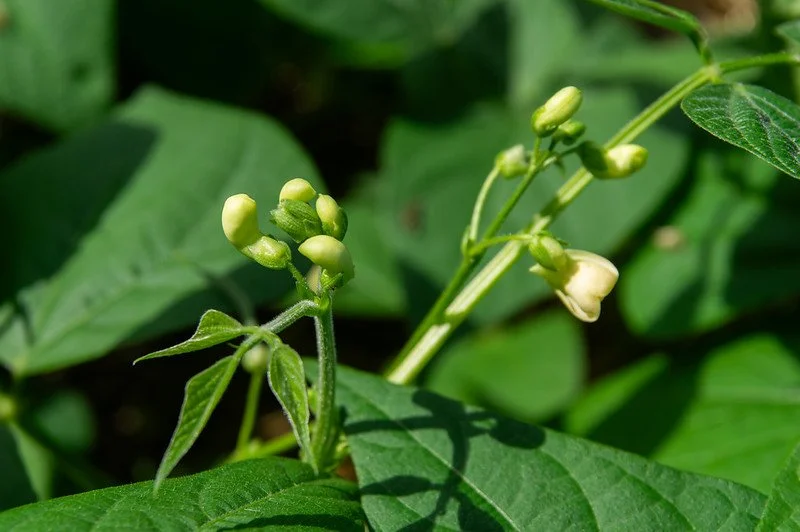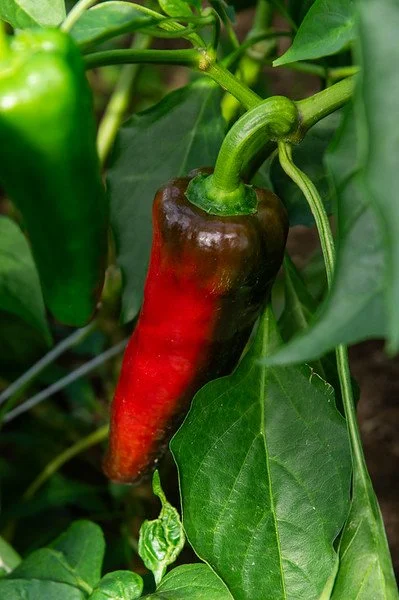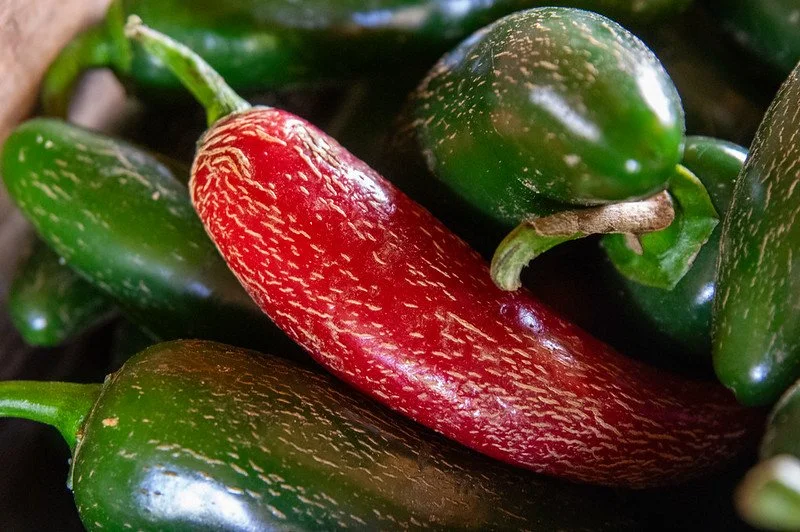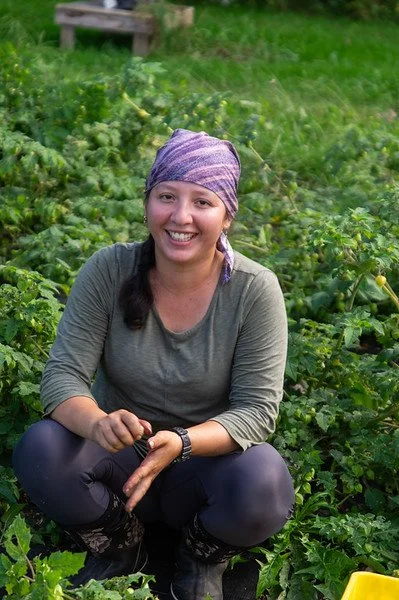16th Week of the Summer CSA season: Week of September 19th
This is one of the brussels sprouts fields with a healthy under sown clover cover crop in the understory. As soon as we removed the tops of these plants a few weeks ago, the brussels sprouts started noticeably sizing up… couple more weeks and they should start to be ready for harvest. Photo by Adam Ford
CSA Balance Due
Please pay for your CSA share if you haven’t already made plans with us for an alternate payment plan. Or reach out to make an alternate payment plan. It saves us a lot of computer time when we could be keeping up with field work to have those payments in. Thank you!
If you haven’t already paid, your balance is due. You can pay online through your account (with a card or e-check ACH payment), mail a check to Evening Song Farm 48 Nice Road, Cuttingsville VT 05738, leave a check or cash in the CSA cash box at the barn, send money with Venmo @eveningsongcsa, or use EBT. It’s very cool to pay in smaller chunks, just let us know what your payment plan is.
Napa cabbage field… should be ready to harvest in a few weeks. We love red and green napa for fresh eating, sauteing, but mostly for kimchi making… one of our favorite ferments for breakfast, photo by Adam Ford
With the season extension we have been experiencing as the climate shifts, we have been planting later plantings of green beans since we count on a later frost… these are looking good for a harvest in a few weeks, photo by Adam Ford
This Week’s Availability
This week we will have yellow beets, red beets, parsley, scallions, baby lettuce, spinach, arugula, baby bok choi, green curly kale bunches, lacinato kale bunches, zucchini, garlic, husk cherries, Carmen sweet red peppers, green sweet Carmen peppers, poblano peppers, jalapeño peppers, green serrano peppers, mini green snack peppers, green tomatoes, sweet onions, shallots, leeks, carrots,we cherry tomatoes, plum tomatoes, heirloom tomatoes, beefsteak tomatoes, Painted Mountain grain corn, and brussels crowns.
*Painted Mountain Grain corn is a gorgeous flour corn that we use to make tortillas and empanadas, or for decorating, and also as beads by drilling holes through the kernels! To use it to cook with, we break the kernels off the cob, nixtamalize it, then grind it. We have a hand crank grain grinder, but we have heard from folks that they have used a food processor to turn the soaked kernels into a flour for tortillas and empanadas. If you are interested in trying it to cook with it and haven’t nixtamalized corn before, here is a fine tutorial. We use wood ash as the calcium hydroxide in that recipe.) If you want to try making corn beads, you can take the smallest drill bit you have, and carefully drill a hole through the center of a corn kernel on the edge of the ear, and then push the drill bit through the line of kernels on the cob, usually drilling 8-10 kernels at a time. Have fun! This is a fun plant because we love how it creates beauty and food in the house.
If you do any bulk preserving, now is a great time to snag jalapenos or if you use any for fermenting, hot sauce, pickled jalapenos, jalapeno jelly, or whatever! We have 8- and 10-pound bags of frozen elderberries available (as well as a couple random-sized small bags), and if you are inspired to preserve any sweet red Carmen peppers for the winter, now is a good time for that as well. (We slice and freeze them, dry them, and roast and puree them into a sauce for the freezer.) Send us an email for wholesale pricing on anything you are looking to preserve.
Ordering closes at noon on Tuesdays for Wednesday bags, and at midnight on Wednesdays for Friday bags.
You do not need to fill out the form if you plan to come to the barn on Tuesdays, Wednesdays or Thursdays to pick out your items yourself.
Carmen pepper, photo by Adam Ford
a solitary eggplant flower among the plants that have stopped putting out fruit for the season, photo by Adam Ford
jalapenos, photo by Adam Ford
Farm News
This week we removed many of the tomato beds, as well as the snack peppers, Carmen peppers, poblano peppers, and basil from the tunnels to prepare for winter greens. (Many of those things we have plantings of outside or in another tunnel, so a few more weeks of summer bounty is still in the cards.) We started transplanting beds of baby lettuce, kale, and chard, as well as direct seeding many beds of the mesclun mix into the newly available space. Next week we hope to finish the tunnel transitions, and have all the winter beds planted or seeded. It’s a tough transition for me, to rip out plants that are still growing and fruiting well, but if we don’t start the winter greens at a precise time, they won’t grow in time for late fall and winter harvests. It’s always a balancing act to make sure we have enough diversity for all the weeks of CSA.
This summer I used some newsletters to write about the climate change cohort I am participating in. One part of the project is to start getting new ideas out there into the world about farming as climate work. (Check out the 2nd, 3rd, 4th, 10th, and 11th week newsletters if you are curious about this topic and haven’t read about it yet.) The last message frame from Action Circles is below in bold, the un-bolded words are their explanation for that message frame, and the italics are my own thoughts.
Agriculture is one piece of the climate solution, and it is not the only solution. We need systems change.
Addressing climate change requires major systems change in both our economy and our food system.
Our systems have been designed for fossil fuel consumption since the advent of the personal motor vehicle, and our agricultural system’s reliance on fossil fuels and extractive practices had its earliest seeds sown as a reaction to the Dust Bowl. To truly tackle the climate emergency, we need to design and implement new ways of living and meeting our needs that aren’t rooted in the limitless growth paradigm of capitalism, but within the reality that the earth has finite resources, but also rich and myriad resources if managed and maintained well.
We need to change how we feed people. This change can come from consumer demand, but it also needs to come from changes in state and national policy priorities.
It does make a difference to shop local and purchase organic when possible. It signals to producers that there is a cultural appetite for climate friendly eating. But in 2020 Americans spent $1.81 trillion on food, and (an impressive!) $62 billion of that was certified organic. But that means organic purchases only represented 3.4% of the food purchased in this country. Consumer demand is not going to change our systems without new national policies, making that shift more accessible for everyone. Those national policies need to include a transition away from subsidizing commodity crops, providing a national healthcare coverage to farmworkers (everyone, really, but we gotta start somewhere), paying farms for the ecosystem services they provide when their practices address the climate emergency, subsidize organic food for consumers, bolster regional production aggregation and distribution facilities, to name a few. It’s a big project, but we need to start thinking way out of the box to solve the catastrophe we are in.
The food system needs revolutionary cooperation and transformational partnerships between farmers, researchers, policy makers and experts to make climate friendly farming mainstream.
Why is organic the niche market, and why is chemical farming and topsoil degrading methods the mainstream way to farm? Shouldn’t we all get to consume clean food? Shouldn’t we protect the finite resource of topsoil, the way we did for water in the 70s?
Farmers cannot be the only players in building a climate friendly food system.
Honestly, I am often too busy with the fast-paced circus that farming is to really do anything besides juggle my parenting role and get some sleep. Across the board, farmers are BUSY… we need more folks to help push forward a climate solution for agricultural policy. There are many organizations out there pushing great policy work and getting their seat at the table to address parts of agricultural issues, piecemeal. Organizations like NOFA-VT work hard on these issues. Become a member if that’s important to you to see that work flourish.
That’s it on their message frames. This cohort continues to do farm visits around the state to learn from each other about what practices are employed to grow food with a changing climate. This summer’s tours have all been through the lens of the catastrophic flooding around the state this year, since it affected everyone in some way. I continue to learn from other farmers as we adapt what we do here, and I feel lucky to get to augment our production skills through that lens. I’ll be one of the presenters at a statewide conference this fall discussing these topics, and exploring how we push this part of the agricultural movement forward with a climate focus. I feel lucky to get to share my voice in that way, since it is why I started farming in the first place.
Have a great week,
-ESF Team: Ryan, Kara, Cindy, Galen, Katie, K2, Taylor, Vanessa, and Bryan (and Sky and Soraya)
Weekly Recipe
the team pulled a lot of tomato plants this week to make room for transplanting winter greens… here are the roots from one of the plans, photo by Adam Ford
lacinato kale, photo by Adam Ford
The soil steamer! We rent this soil steamer once a year to steam the soil in the tunnels between summer and winter crops to manage weed seeds and disease. In the fields we manage weeds and disease with cover cropping and rotations, but tunnel management is tricky… It’s such a high value space to use at all times, so resting the soil with cover crop rotations isn’t a typical use of tunnel space. We are continually evaluating our tunnel management, and we will continue to explore those plans this winter, photo by Adam Ford
green tomatoes get harvested from the tomato plants before we pull them, and then spread out in the prop house under the shade cloth, photo by Adam Ford
bee visiting with a marigold, photo by Adam Ford
…. because, as cool as it is to manage weeds and disease with steam (and not chemicals), the steam is generated by burning an embarrassing amount of fossil fuels, and that’s just not a tool we want to continue to rely on. The amount of fuel we use in a week for the steam is about the same amount of fuel we use for the entire rest of the year with our tractor. We designed this farm to not rely on fossil fuels (the propagation house is heated with pellets and a solar heated water, for example) so using this steamer has introduced a climate conundrum for us, photo by Adam Ford
sunflower monuments, photo by Adam Ford
Vane in the husk cherries, photo by Adam Ford
beautiful red Napa cabbage, photo by Adam Ford
Taylor in the husk cherries, photo by Adam Ford
pick-your-own garden, photo by Adam Ford
husk cherry field, photo by Adam Ford
if Ryan’s not getting cover crops seeded in one field…. photo by Adam Ford
here’s a fun picture for ya…. last week someone from the Vermont Land Trust stopped by to chat before the award ceremony where we were receiving a grant from them. He hadn’t been at this property since 2012 when we were trying to secure their help in accessing land. He was really impressed with everything that has changed here in the past 11 years, and he emailed this picture along to remind us of what it looked like back then, image provided by Donald Campbell
here’s another from 2012…. our old manure spreader with a load of compost coming off the back to prepare a garlic field a few months after Irene, photo by Donald Campbell
plum tomatoes, photo by Adam Ford
baby apple tree, photo by Adam Ford
then he’s getting them seeded in another field, photo by Adam Ford
he also attached this picture which is from 2022, so it doesn’t include the new solar building, but does show a tremendous amount of change to these fields… we have enjoyed and cherished arial photos like this to give a bird’s eye context of how much has been established here to produce veggies, but it is especially cool to see it side by side from the first photo when these fields were open hay fields with a driveway running through it, image provided by Donald Campbell
essentially from the same spot in 2023…. with a house about where that manure spreader was in the previous picture , photo by Kara


























